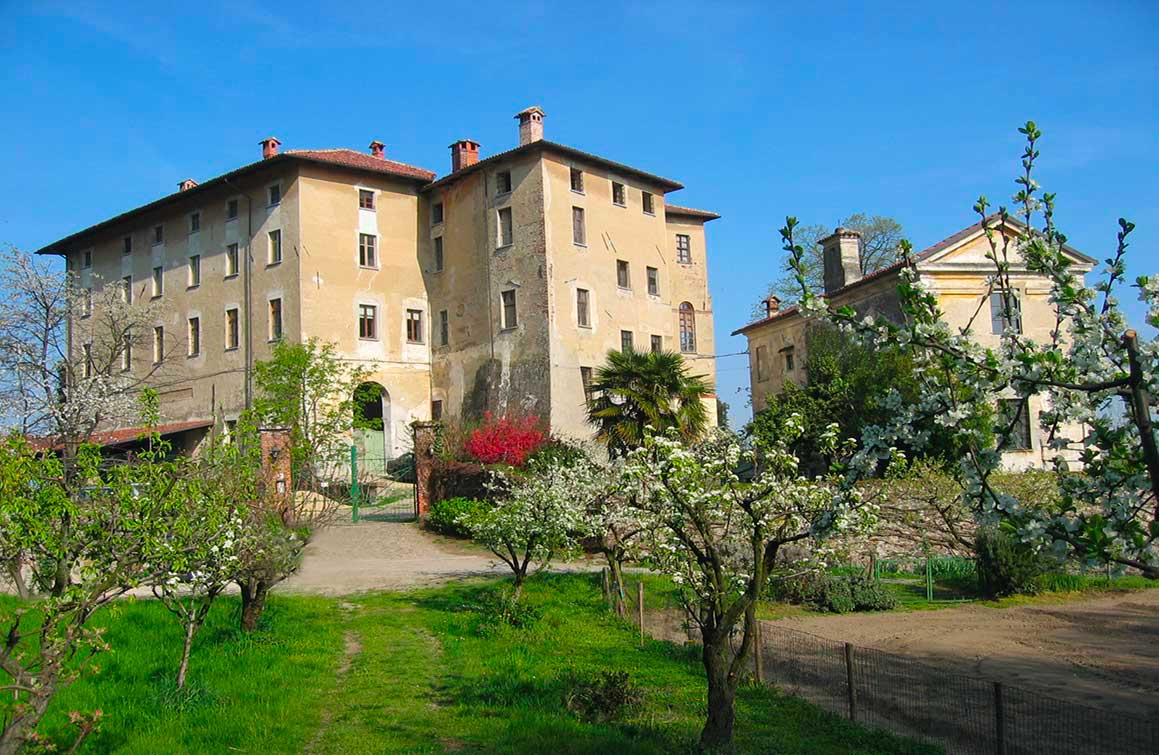Storia del Castello di Camerletto
Dall’Abbazia di Novalesa ai giorni nostri
La storia del Castello di Camerletto di Caselette, oggi Bed & Breakfast, risale all’anno 850, dove due nobili della Valle di Susa, Erigario e la moglie Lea, donarono all’Abbazia della Novalesa alcune terre in Caselette che costituivano la curtis Veseneribus, nucleo originario di Camerletto,un centro agrario presso il mons Versenius ( monte Musiné). Fu abbandonato nel secolo successivo, quando, dopo il 920, i monaci della Novalesa, fuggiti alle scorrerie saracene, si rifugiarono prima a Torino e poi a Breme.
I primi documenti scritti risalgono a prima dell’anno mille, quando l’imperatore Ottone conferma la proprietà del castello all’Abbazia.

Le fondamenta sono forse molto più antiche: il ritrovamento nel 1700 di un campo di urne durante lo scavo della bealera nelle vicinanze, fa pensare a un sito o a un castelliere gallico, a guardia della strada principale della valle, e il primo nome del castello “Castrum Merletum” ci rimanda a un accampamento militare romano.
La grangia fortificata, che fu ricostruita all’inizio del XI secolo, si occupava dello sfruttamento agricolo di un ampio territorio intorno al castello.
Nel XVII secolo fu affidata dai Benedettini della Novalesa ai Certosini e poi ai Cistercensi Riformati, chiamati Foglianti.
All’inizio del ‘700 l’edificio fu ristrutturato a opera dell’ Architetto Antonio Bertola, responsabile dell’ attuale sobrietà della struttura architettonica.
All’inizio del XIX secolo divenne proprietà della famiglia Ferrero Ponsiglione conti di Borgo d’Ale, di cui rimane il ricordo nello stemma gentilizio recuperato sulla volta dello scalone principale.
Alienato ai Missionari della Consolata, che lo trasformarono in seminario e scuola artigiana, da metà degli anni 50 appartiene alla famiglia Paschero, che con entusiasmo e passione si sta occupando del suo recupero.
La lunga storia del castello, caratterizzata da periodi di ampliamenti e da momenti di distruzione nei vari conflitti, giustifica la stratificazione architettonica dell’immobile e lo rende particolarmente originale ed interessante.

Built before the 10th century, at the foot of Mount Musiné and at the entrance of the Susa Valley, the Castle of Camerletto has witnessed the passage of history within its walls.
The first documents date back to before the year 1000 after a period of abandonment due to Saracen raids. The foundations, perhaps much older, suggests a site of a Gallic castle guarding the main road of the valley.
In the XVII century it was entrusted by the Benedictines of Novalesa to the Reformed Cistercians,called Foglianti, responsable for the present sobriety of the architectural structure.
At the beginning of the 19th century it became the property of the Ferrero Ponsiglione family, whose memory remains in the coat of arms recovered on the vault of the main staircase.
Since the mid-1950s it has belonged to the Paschero family, who have been taking care of its recovery with enthusiasm and passion. The long history of the Castle is responsible for the architectural stratification of the building that makes it particularly original and interesting.

Construit avant le Xe siècle, au pied du mont Musiné et à l’entrée de la vallée de Suse, le château de Camerletto a été le témoin du passage de l’histoire dans ses murs.
Les premiers documents datent d’avant l’an 1000, après une période d’abandon due aux raids sarrasins. Les fondations, peut-être beaucoup plus anciennes, suggèrent un site d’ un château gaulois gardant la route principale de la vallée.
Au XVIIe siècle, il fut confié par les Bénédictins de Novalesa aux Cisterciens réformés, appelés Foglianti, responsables de la sobriété actuelle de la structure architecturale.
Au début du XIXe siècle, elle devient la propriété de la famille Ferrero Ponsiglione, dont le souvenir est conservé dans le blason retrouvé sur la voûte de l’escalier principal.
![]()

![]()
![]()
